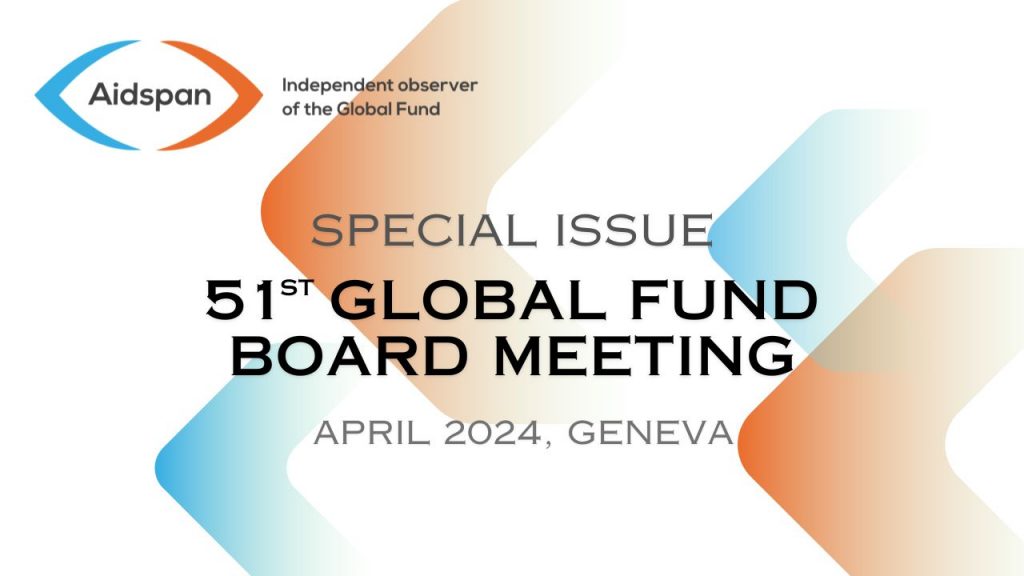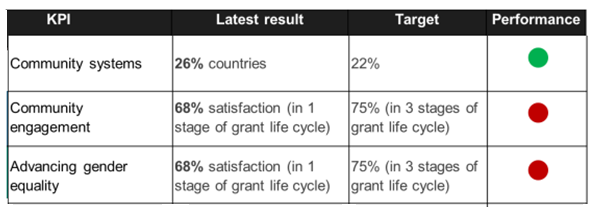
2023-2028 Strategic Performance Report – A Summary
Author:
Madhuri Kamat
Article Type:Article Number: 11
The Global Fund 2023-2028 Strategic Performance Report is a collation of information across other reports and here we focus on what some of its actual plans are. We provide a summary of the report and the future look of things in our article as well as feedback from stakeholders at the 51st Global Fund Board Meeting.
The Global Fund’s 2023-2028 Strategy Performance Report acknowledges where it’s reached its planned targets and where it hasn’t and accordingly sets out what it aims to do so as to reach where it aims to be. Below is a summary.
Procurement and Supply
Supply continuity refers to the required quality-assured suppliers having the 33 products identified as a priority across HIV (14), TB (11) and malaria (8); covering treatment (24), diagnostics (5), preventive (3) and preventive and treatment both (1).
The continuity in supply and new products have been standout performers, scoring cent per cent in the latter and 97% in the former (Figure 1).
Figure 1: KPI Summary

Health Governance
While the Global Fund was on target with community systems, it’s because it set the bar low at a target of 22% and achieved a 26% target. Where it set the bar high, community engagement and advancing gender equality, it’s nowhere even close to the target. Community engagement is off course, with the 75% target not achieved even in the third stage of the funding cycle, when it was meant to be attained in the first stage. Ditto for furthering gender equality (Figure 2).
Figure 2: KPI Summary

Financing
Against their targets, realization of domestic co-financing commitments (68% of 85% target) and pledges for Grant Cycle 7 (87% of 100% target) have faltered and pledge conversion is nearing attainment with just 2% left of the 30% target but has already crossed this level due to a significant payment coming in late by just a month. However, mitigation of co-financing risks (79% of 80% target) and corporate asset realization (96% of 95-98% target) raced towards the finish line. What did not, however, is the quality of external audit process, with only 47% of the expected 80% fulfilling this goal (Figure 3). This is explained by the Global Fund due to the fact that often countries are not prioritizing giving assurance reports regarding development assistance from funding partners since they are more focused on their own in-country compliance requirements.
Figure 3: KPI Summary

So, overall, it means that finance is a leaking ship, supply and procurement are bobbing along, but, and it’s a big but, health governance is in danger of having the wind taken out of its sails by the blotchy human rights record.
The Global Fund is trying a reset and this is a summary what it looks like.
Global Fund 2023-2028 Strategy Performance Report: Excerpts
Community Engagement in Health Sector Planning and Governance
Strengthening organizational capacity and leadership development of community-led and -based organizations are not well justified or linked to service delivery and engagement in national and Global Fund processes using data from community-led monitoring mechanisms.
Require a partnership-wide approach to meaningfully respond to policy restrictions in current context and global movements towards criminalization and gender backlash for improved public health outcomes.
Need for improvement in community-led research and advocacy and community engagement, linkages and mobilization in support of broader health responses and Universal Health Care.
During 2024, the Community Responses and Systems Strengthening (CSS) team will be established and operational at the Secretariat, critical to drive further progress where gaps persist.
The risk management framework in 23 countries will be used to routinely monitor CSS at country level. Additionally, three connected initiatives to:
- a) strengthen the capacity of nascent community-led organizations and their operations for service delivery (quality, effectiveness);
- b) reinforce Community-led Monitoring (CLM) data use in routine program reviews and quality assurance processes (health system functions, quality of care, Primary Health Centre); and
- c) Community engagement through CLM in Pandemic Preparedness and Response (PPR) will be implemented during GC7.
HIV
- Incidence reduction is a priority. GC7 investments optimize targeting of resources to scale up prevention options to those most at risk of HIV acquisition, as part of national programs.
- Investments to address mortality include using data to target testing and rapid linkage to ART in populations with low ART coverage, and support for investments in prevention/treatment of co-infections (especially TB) associated with HIV-related mortality.
- Pediatric HIV in focus for innovation – support to use of dolutegravir-based treatment formulation for children.
Tuberculosis
- Need to continue to find and successfully treat missing people with TB, particularly in hard-to-reach populations and providing patient-centered care to reverse mortality trends.
- Early and accurate diagnosis, a focus on TB prevention (including TB Preventive Treatment and an effective TB vaccine)
- Address undernutrition, HIV, alcohol, smoking & diabetes risk factors will help reverse incidence trends.
Malaria
Financial optimization approaches and next gen market shaping efforts around commodity prices will support in addressing the funding challenges but this will not be enough.
Appropriate programming and response to the heterogeneity in context.
GFs support for countries to conduct robust surveillance assessments supporting sub-national root-cause analysis and continuous quality improvement.
Insecticide-treated Nets for malaria
Enter advance market commitments with suppliers to secure improved supply terms (Revolving Facility) – the first use case in GC7 are dual active ingredient (Dual AI) insecticide-treated nets made by Vestergaard’s PermaNet.
[You can read about the controversy around PermaNet and other nets here].
Domestic Resource Mobilization
Track implementation of mitigation actions for countries at risk of not meeting their co-financing commitments.
Prioritizing domestic investment in health from the available fiscal space is a political decision. The Global Fund also places co-financing and domestic resource mobilization for the three diseases at the heart of its political engagement, advocacy and messaging.
Innovative Financing
Debt2Health (D2H) – Global Fund’s own debt swap program:
Creditor nations forego repayment of a loan if the debtor nation invests all or part of the freed-up resources into a Global Fund-supported program, aligning with the National Health Strategy.
Blended Finance:
Combine grants with investments of multilateral development banks and other development finance institutions in select countries so as to help encourage new financing for health or influence existing financing and lending in support of HIV, TB and malaria and resilient and sustainable health systems (RSSH) strengthening objectives.
Covid-19 Response Mechanism (C19RM) Grant
An approved C19RM investment shift of US$ 2.2 billion is to be implemented during the extension phase in 2024 and 2025. The shift also illustrates an opportunity to execute the largest RSSH investment in the history of the Global Fund.
Value for Money and Financial Sustainability
Systematic look at grant financing flows to understand and assess the sustainability of investments and to link co-financing commitments to grant financing as well as country budgets.
Work to integrate HIV, TB and malaria interventions into National Health Insurance in some countries (e.g., Nigeria and Côte d’Ivoire).
Strengthen Public Finance Management including via using grant funding dedicated to Health Financing system strengthening.
Develop a roadmap to better integrate economy, efficiency, and equity into the grant cycle following the recent Value for Money audit by the Office of the Inspector-General of the Global Fund’s health and laboratory-related equipment investments.
Regional Manufacturing
Continue strengthening collaboration with partners including African institutions, PEPFAR, USAID, WHO, and Unitaid to promote capacity building for regional manufacturing.
Initial focus of the NextGen approach is to support capacity building for regional manufacturing in Africa, where the biggest gap exists between high-volume demand and supply.
Stakeholder Feedback at the 51st Global Fund Board Meeting
The stakeholder discussions revealed a robust engagement with and commitment to addressing key risks and performance metrics. There is a clear directive from stakeholders to not only maintain focus on these critical areas but also to enhance strategies to ensure that the organization’s objectives are achieved in an effective and equitable manner. These discussions will guide future strategic directions and help in refining the approaches towards achieving the desired outcomes. Among the issues discussed included improving the mechanisms for data collection and analysis to ensure that strategic decisions are based on accurate and timely information. There was interest in understanding of mechanisms in place for ensuring data accuracy and how useful is the “green marker”, a tool to track gender equality initiatives and how it is being integrated into broader performance metrics of co-financing. There was a call to broaden the approach to regional capacity building by taking into account the lessons learned from the COVID pandemic when there were stockouts and other impacts. The Global Fund can learn from countries that have transitioned out with regards to their best practices in domestic public-private partnerships for pharma production.
As the news came in of a Dominican court in the Caribbean striking down laws criminalizing same-sex relations among consenting adults, it was upheld as an example of effective collaboration between civil society organizations, international NGOs and UN partners. Stakeholders pointed out that these legal wins need to translate into attitudinal changes to ensure increased access to services for the LGBTQI+ communities. The Global Fund was also urged to move beyond mere expressions of concern regarding human rights’ violations, as it did in its response to the Uganda Constitutional Court’s ruling on Anti-Homosexuality.
Conclusion
The Global Fund relies on improving health outcomes through strategic, data-driven, and rights-based approaches. But in the famous words of Ezra Pound, it “cannot make it cohere”. So far. The Board, technical and bilateral partners must help the Secretariat find its way through the “tangle of works unfinished”.
